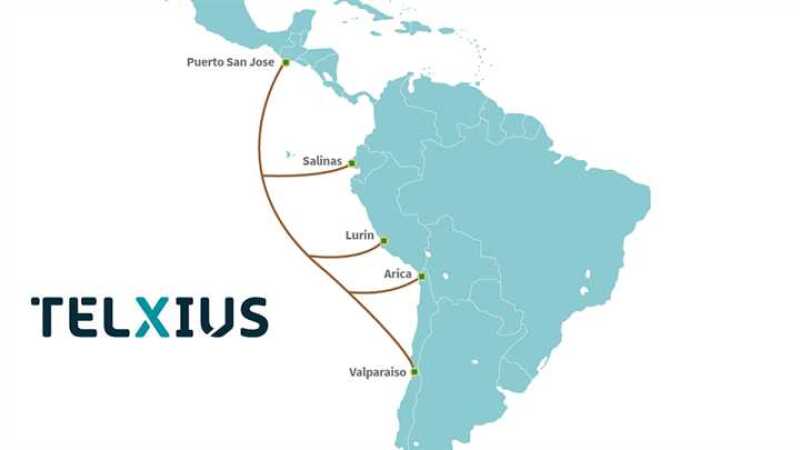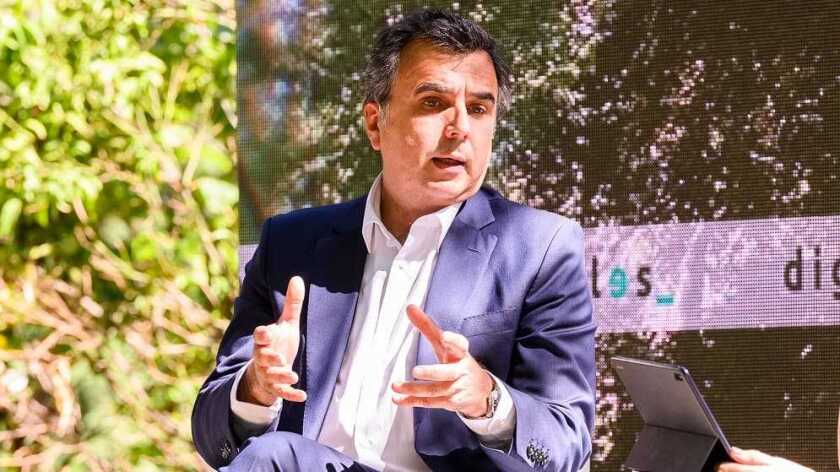It was during International Telecoms Week (ITW) 2019 that we first heard news of Telxius’s plan to partner with América Móvil to build a new subsea cable system along the Pacific coast of Latin America.
Named after Lucila Godoy Alcayaga, otherwise known as Gabriela Mistral, the Latin American poet and the first Latin American woman to receive a Nobel prize, the 7,300km system that we now know as Mistral is the first subsea cable since 2001 to connect Puerto San José in Guatemala with Valparaíso, Chile, with additional landing points in Salinas, Ecuador; Lurín, Peru; and Arica, Chile.
Telxius CEO Mario Martin says that the 20-year absence of another cable in the region, was the reason a decision was taken to build this system.
“The fact was that no submarine cables had been built between Guatemala and Chile since 2001, so the Mistral cable project was born with the understanding that the South American Pacific market had connectivity challenges that needed to be addressed in order to reduce its digital gap and strengthen its internet services.”
Overall, he says, the deployment of Mistral with América Móvil “aims at boosting communications in the Pacific coast of Latin America, with a potential capacity of 132Tbps”.
Shedding light on the technical specification of the system, Martin shares that it will be a six-fibre pair cable, making it more of a “traditional cable than an SDM (Space Division Multiplexing) cable” that is popular for maximising capacity on deployed fibre.
To its benefit, the fibre pairs on Mistral are designed with “the best optical fibre in the market and the optical amplifiers are spread over the length, maximising the capacity per fibre pair and the distance reach without regeneration”, explains Martin.
He says that this approach enables Telxius to, for example, “integrate the Mistral cable into the Guatemalan terrestrial crossover in a way that no additional regeneration is required and the cost per bit transmitted is optimized”.
Over its expected 25-year lifecycle, Martin says, Mistral is “designed to evolve with the growing demands for Internet services, data and content”; at the same time the system is also “capable of carrying new 400G Ethernet circuits and, in a few years, when 800G becomes a reality, Mistral will most likely be the only cable in the Pacific to offer such circuits to the market”.
Having gone live in August 2021, Mistral forms part of the Telxius international submarine cable network; as such, “all Telxius cables are interconnected and Mistral is no exception,” explains Martin.
Specifically, “from Chile, and through our trans-Andean network, Mistral connects with Tannat and SAm-1 in Buenos Aires, and from there with Junior, Brusa and the rest of Telxius’s submarine cable network.”
Over the on the Pacific side of the cable, Telxius has three different onward connectivity options to reach the US – to Miami via SAm-1 from Guatemala; to Jacksonville via PCCS from Ecuador; and to Virginia Beach through Pacific Caribbean Cable System (PCCS) and Brusa also from Ecuador, according to Martin.
As for the decision on whether or not the system will connect directly into the data centre or leverage cable landing stations, Martin indicates a little of both.
“Mistral’s five landing stations (San Jose, Salinas, Lurin, Arica and Valparaiso) reach the main data centres in the Pacific region through our points of presence (PoPs) and specifically deployed terrestrial backhauls,” he says.
Across its footprint, Telxius has a global presence in almost 100 locations, comprised of PoPs and landing stations in America and Europe. In the Pacific region this makes up almost 20 locations, all of which have terrestrial backhauls connected to the main data centres in the region.
Interestingly, partnering with América Móvil on the development of this system, Martin says, aligns with the company’s ethos of collaborating with other operators and OTTs, as evidenced by its previous subsea projects Marea, Dunant, Tannat, Junior and Grace Hopper, which were all collaborative efforts.
In the case of América Móvil, as one of the largest telcos in Latam, the synergies were already there.
“The Mistral cable is designed to achieve significant efficiencies from infrastructure sharing, and this collaboration with America Móvil reflects the continued commitment of two of the largest telecommunications groups operating in Latin America to offer the most advanced technology and the lowest latency to our customers and partners in Latin America,” adds Martin.
With Mistral’s launch a regional first in more than 25years, Martin says the response from the market has been exceptional, adding that its clients see this new piece of infrastructure as “an opportunity to boost their businesses, supported by more modern and higher-capacity infrastructures” and the vehicle that will power “Latin America to fully participate in the global digital economy”.

As conversation turns to industry at large, it is unavoidable that the topic of Covid-19 and its effect on the infrastructure space comes up.
“Without any doubt, we have all seen how the pandemic has changed many aspects of our lives and Internet services are certainly one of them,” Martin says. “The rise of teleworking and the increased use of entertainment platforms due to spending more time at home added pressure on the services provided by operators.”
In Telxius’s case, he says, the company was already prepared for a global data traffic increase “as a consequence of the emergence of new technologies such as 5G, Artificial Intelligence, the Internet of Things (IoT) and the future connectivity needs derived from digitalisation”.
As a result, the pandemic merely accelerated the onset of this predicted increase in data traffic, with Telxius infrastructure already prepared to scale up.
“Our network was able to manage increases of more than 55% in IP traffic in 2020,” explains Martin.
“Moreover, in the first half of 2020 we increased the provision of capacity on our network by 140% compared with the first half of 2019. We had never provisioned such large capacities on the Internet IP ports in such a short time, before the pandemic and lockdown months.”
Pandemic aside, the other biggest drivers of increased infrastructure development are the maturation of the cloud, video, IoT and 5G services, in Martin’s view, and all are “progressing steadily”.
“Digitalisation is accelerating at a fast pace and the pandemic has contributed significantly to it,” adds Martin. “From our perspective, this means that we must strengthen our efforts to continue to support global connectivity and communications together with our partners.”
One increasingly important discussion being had not only across the infrastructure space but the telco sector as a whole is that of sustainability and green energy. Though subsea is largely sustainable, compared with other communications infrastructure, I was keen to know how Telxius is managing this across its business.
“Our business always goes hand in hand with a necessary and beneficial commitment for all,” says Martin.
This in turn results in a strategy with three focus areas: environmental management, energy efficiency and information security.
“For each of them we have ISO/IEC certifications that guarantee that we act appropriately in aspects such as environmental risk management, energy consumption and data protection in all the technologies we use,” he continues.
One such example is Telxius’s Derio Communications Hub, which, Martin says, operates using entirely renewable energy, with “high efficiency and flexibility for growth based on our clients’ needs”.
Until June of this year, alongside Telxius’s impressive portfolio of subsea cables the company also held an expansive footprint of Tower assets across Europe.
The deal, valued at €7.7 billion ($9.4 billion), saw it divest its some 34,000 tower sites to American Tower Corporation and lay the foundation for the company to spend around $500 million constructing a “committed pipeline” of 3,300 new sites in Germany and Brazil by 2025.
At the time, Martin took to LinkedIn to thank the Telxius Towers team for a “fantastic journey”, praising the work it took to double its portfolio to reach more than 34,000 sites over the past five years. He ended in giving credit to “the sensational efforts of an outstanding team, without whom none of this would have been possible”.
Speaking on the deal and what it will mean for Telxius, he shared that the transaction was “great news” for Telxius and its shareholders “amounting to €7,700 million at an unprecedented 30.5x EBITDA multiple”.
With no direct impact on its subsea business, Martin confirms that Telxius “had already focused on the development of submarine cable infrastructure and services to address the upcoming connectivity needs”, a strategy that has been reinforced by the divestment of its Tower assets and one that will continue for the foreseeable future.
“At Telxius, we are now fully focused on continuing to develop and strengthen our cable business,” he says.
“The sector is expected to keep growing globally; therefore, we are currently devoting all our attention and assets to the submarine cable business.”
With this mind, the long-term strategy for the company is underscored by one central objective – which is to continue developing subsea communications infrastructure in readiness for a future dominated by increasing digitalisation.
Therefore, Martin is steering the Telxius ship and setting it on course for continued close collaboration with its customers “by offering flexible solutions, entering collaborative partnerships within the industry and enabling communications globally”.






